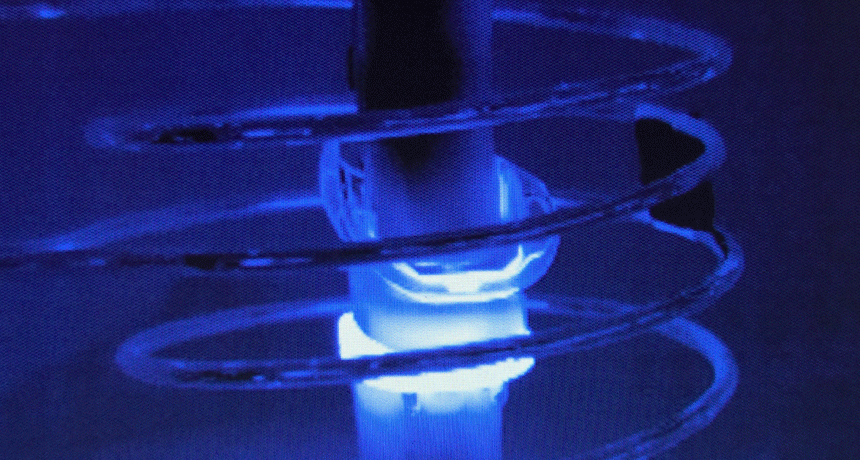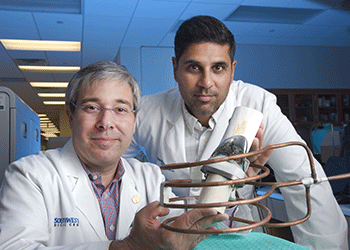Magnetic heating may replace surgery to cure some infections
Scientists are testing the approach on hard-to-treat infections on artificial joints

An electromagnetic coil around a limb would selectively heat metal in an artificial joint (shown inside coil) without hurting any surrounding muscle and bone. Researchers are testing this approach to treat infections on medical implants.
UT Southwestern Medical Center
By Ilima Loomis
Implanted metal parts — such as artificial joints or pins and plates that hold bones together — can help people with injured or aging bodies. Once repaired, patients often can run, jump and play again. But sometimes bacteria in the body find and hide out in these implants. When this happens, it may take surgery to rout those germs. But what if doctors could kill those germs from outside the body, without drugs or cutting someone open? Two scientists are developing a way to do just that. The trick to make it happen: a special magnet.
One reason these infections can be so tough to treat is that they form biofilms. These are thin sheets of bacteria and other gunk bind together beneath a protective, sticky layer. Plaque growing on teeth is one type of biofilm. But while you can scrub away plaque with a good toothbrush, a biofilm isn’t so easy to get rid of when it’s inside your knee or sandwiched beside a titanium plate in your toe. Only about one or two percent of patients with artificial joints develop one of these infections. But that still adds up to a lot of people.
And once they develop, such infections can be very painful and expensive to treat. Often, the patient needs more surgeries to remove the infected joint and put in a new one. They may also need a lot of antibiotics.

David Greenberg started puzzling over a new solution. He is a doctor and researcher who works on preventing infections. “What are the ways we could prevent that original joint from being removed if it got infected?” he wondered. He talked with one of his colleagues, Rajiv Chopra. Chopra is a biophysicist. That’s a scientist who studies how physical forces relate to living things. Both work at the University of Texas Southwestern Medical Center in Dallas.
Together, they thought about MRI, or magnetic resonance imaging. Doctors often use this imaging technique to view soft, internal organs, like the brain, muscles and heart. An MRI machine uses strong magnetic fields to create those images.
But when those magnetic waves interact with metal, they can create heat. That can make it dangerous for some people with metal implants or electronics in their bodies to get an MRI scan. But what if doctors could use that heat in a way that helped patients? “We kind of turned the concept on its head,” Greenberg says.
Magnetic heating
In some instances, engineers will deliberately use changing magnetic fields to create heat. This process is known as induction heating.
When electricity flows through a wire, it creates a magnetic field around it. Where the electricity used is an alternating current (AC), the direction of the flow of electricity repeatedly and rapidly changes direction, back and forth. (This is the type of electricity that comes out of a home’s wall outlets.) AC current makes the magnetic field around the wires also change. If a metal object (or any material that conducts electricity) is brought near this alternating magnetic field, electrical currents will begin to flow through that metal. Since a metal will offer some resistance to the flow of electricity, some of the energy in the electrical current that is induced in the metal will be dissipated as heat.
No current will be induced in materials that don’t conduct electricity, such as tissues. So they remain comfortably cool.
Greenberg and Chopra wanted to know if this heat could be harnessed to kill harmful bacteria without harming the patient. To test their idea, they placed a piece of metal with a biofilm growing on it into a test-tube. Then they turned on the alternating magnetic field.
And it worked! It heated the metal and “melted” away the biofilm.
Now it was time to find out how heating an implant might affect the rest of the body. Muscle and bone don’t conduct electricity. So they wouldn’t heat up directly. But just as touching a hot pan can burn your hand, heating implanted metal could burn tissues that were in contact with it.
“If you think about using heat like a drug, what is the best dose of heat you need to kill off any biofilm, but not damage any surrounding tissues?” Greenberg asks. To find out, his team tested the process on mice. These animals had small metal pellets implanted in their legs. The pellets didn’t have biofilms. But they helped test the safety of heating a metal implant that would be in touch with living tissue.
From these test data, he says, “It actually looks like flash heating — just a burst of high power — is safer than slow and steady [heating].” His team will do more tests in animals before trying the technique in people.
What about antibiotics?
Although drugs can move throughout the body, they don’t tend to home in, like a bullet, on any particular region. That’s why they haven’t been a so-called magic bullet for tackling the infections hiding out in implants. However, Greenberg and Chopra tested the use of these germ-fighting drugs together with inductive heating. And, Greenberg now reports, “It turns out the two together work far, far better than either one of them alone.”
That’s important because it could make treatment safer. By combining heat treatment with antibiotics, doctors might cure an infection with a smaller of each compared to what they would need if either had they been used alone. The researchers described their findings in the August 7, 2017 Scientific Reports.
Douglas Osmon is an infectious disease doctor at the Mayo Clinic College of Medicine in Rochester, Minn. He works with orthopedists, those doctors who specialize in problems affecting the bones and joints. Finding a non-invasive way to treat biofilm infections has long been a goal for doctors who work with medical implants like artificial knees, he notes. It would be especially useful if it limited — or eliminated — a patient’s need for antibiotics, he notes. Those medicines can have side effects.
However, he points out, it’s too soon to know if alternating magnetic fields will cure internal infections in people. The scientists have only tested it on tiny metal pellets in mice. And real implants, these days, usually are not all metal; they also tend to have some plastic parts. And they’re held in place with bone cement or screws. Will flash heating melt the plastic or damage the cement? Will it hurt or loosen implants that are screwed directly into the bone? These are important questions to answer, Osmon notes.
“You’re kind of throwing the baby out with the bathwater if you cure the infection but hurt the [implant],” he warns. Still, he concludes, the new findings are very promising.
This is one in a series presenting news on technology and innovation, made possible with generous support from the Lemelson Foundation.







